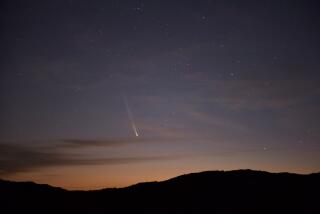PERSPECTIVE ON COMET HYAKUTAKE : An Otherworldy Visitor Beckons to Our Imagination : No telescope is needed, no background in science to witness this phenomenon and become starstruck.
- Share via
An elderly woman in Tennessee named Mrs. Sanford called me the other day, having seen my name in connection with the comet Hyakutake. Mrs. Sanford and her buddies at the nursing home had formed an amateur astronomy club and had just returned from viewing Hyakutake in the clear Tennessee skies. She first requested assurance that the comet and its long tail would not get dangerously close to Earth and then asked what special techniques she and her friends could use to best observe the comet. After noting that it would get no closer to Earth than 9 million miles, I suggested that simply enjoying the dramatic celestial visitor with her friends was the important thing. Mrs. Sanford said that she was 93 years old and that seeing comet Halley in 1910 from the vantage point of her father’s shoulders was one of her most cherished memories. Before hanging up, she hoped that this new comet was in better shape than she was.
Comet Hyakutake is indeed in good shape. It is the most visually impressive comet since comet West hung in the predawn skies of March 1976, two decades ago. Impressive naked-eye comets do not appear very often, and their arrival cannot be predicted very far in advance, unlike the periodic comets, like Halley. Most of the visually impressive comets, like Hyakutake, have such long and uncertain orbital periods that they take us by surprise.
Comet Hyakutake last approached the Earth’s neighborhood more than 10,000 years ago, when our forefathers were fashioning crude tools from stone. It will be another several millennia before it once again returns. It spends the vast majority of its existence far from the sun, reaching distances more than 10 times farther than the orbit of our outermost planet, Pluto.
When a comet like Hyakutake does return to the inner solar system, the ices of its city-sized nucleus vaporize and release the dust and gas that form the comet’s enormous atmosphere and tail.
Within the solar system, the diminutive size of the icy comets is in no way proportional to their importance to life on Earth. Next to the sun itself, theirs is the most important realm. As the leftover bits and pieces from the outer solar system formation process, the icy comets offer the best chance for astronomers to determine the nature of the primordial gas and dust from which the planets formed 4 1/2 billion years ago. Comets also played a role in the origin and development of life on Earth. Collisions of comets with the early Earth delivered some of our water supply and carbon-based molecules, the building blocks of life itself. Subsequent cometary impacts, however, could have erased many of Earth’s life forms, leaving only the most adaptable to develop further. So to some extent, our very existence and high position within the animal realm is related to comets.
A small army of professional and amateur astronomers is observing comet Hyakutake, using a wide variety of detectors and techniques. Observations are being made using the Hubble Space Telescope and several other spacecraft. Most ground-based telescopes are directed toward the region just above the Big Dipper, where the comet currently resides. But the most enjoyable viewing is done not with sophisticated instruments but with the naked eye. (Binoculars are a plus but not necessary.)
Television and other forms of visual assault have perhaps numbed our senses to the subtle, ethereal beauty of celestial displays. Visual spectaculars are of this age only; cometary apparitions are for the ages. Join Mrs. Sanford and thousands of others in witnessing this stately emissary from the edge of our solar system. You have a few more nights for the best viewing. Abandon the television set for an hour or two, find a location without city lights, hoist your kids on your shoulders and direct their view toward the northern heavens. Your children may not remember the significance of this comet or understand why astronomers went to extraordinary efforts to study it, but years from now, the experience may well be one of their most cherished memories.
More to Read
Sign up for The Wild
We’ll help you find the best places to hike, bike and run, as well as the perfect silent spots for meditation and yoga.
You may occasionally receive promotional content from the Los Angeles Times.






